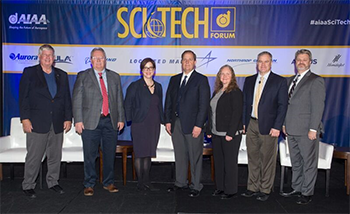Digital Engineering Transforming Manufacturing Written 8 January 2018
Panelists: Moderator Pamela Kobryn, principal aerospace engineer, Structures Technology Branch, Aerospace Vehicles Division, Aerospace Systems Directorate, Air Force Research Laboratory; Brenchley Boden, chief technology officer, Digital Manufacturing and Design Innovation Institute, and senior industrial engineer, AFRL; Michael W. Grieves, executive director, Center for Advanced Manufacturing and Innovative Design, Florida Institute of Technology; Brunon “Dave” Kepczynski, chief information officer, GE Global Research, and engineering product leader, GE Digital; John H. Vickers, principal technologist, Space Technology Mission Directorate, NASA; Chuck Ward, chief, Manufacturing and Industrial Technologies Division, Materials and Manufacturing Directorate, AFRL; Caroline Gorski, global partnership director for digital, Rolls-Royce
by Michele McDonald, AIAA Communications Manager

In the dawn of digital engineering, the challenges are daunting, but the rewards extend far beyond manufacturing, panelists said Jan. 8 during the “The Dawn of Digital Engineering?” forum at the 2018 AIAA SciTech Forum in Kissimmee, Florida.
The panelists said digital engineering could boost efficiency, slash costs, increase agility and reveal problems before production begins. However, they pointed out some challenges, including overcoming cultural biases, navigating through massive amounts of data and figuring out how to retain and make accessible digitized data into the future.
Digital twins and models are disrupting the status quo, though, they said. For example, a digital twin of an airplane can move through its physical counterpart’s entire lifecycle from the design stage to manufacturing to service and support, said Chuck Ward, with the Air Force Research Laboratory’s Materials and Manufacturing Directorate.
“You now have a flying laboratory,” Ward said.
Beyond digital twin prototypes, there are digital twin aggregates, said Michael W. Grieves, executive director of the Center for Advanced Manufacturing and Innovative Design at Florida Institute of Technology. He said these aggregates can help engineers predict when equipment needs to be replaced and that it’s all about prognostics and learning so “later versions of a product don’t have to go through the same learning curves as earlier versions.”
Digital twins and digital engineering may help NASA reach Mars and beyond while cutting costs and saving time, said John H. Vickers, principal technologist with NASA’s Space Technology Mission Directorate. The traditional building block approach can take decades and tens of millions of dollars to get equipment into space.
The Department of Defense is shifting to a digital engineering ecosystem from initial research and development all the way to maintenance and eventually retirement, said Pam Kobryn, with the Aerospace Systems Directorate at AFRL. She said the DOD is working with traditional modeling and simulation while leveraging high-performance computing and software networking.
“The dawn of digital engineering — the questions are all around the unknowns,” Korbyn said, adding that the DOD is looking at the portability of the models, value across the lifecycle, how to speed up the pace of delivery and how to provide simple support to complex problems.
And then terabytes of data must be managed. For that, engineers are borrowing from the field of biology and bundling information into packets, similar to the DNA code, Ward said.
“We need to figure out how to learn from all that data,” said Brenchley Boden, chief technology officer of the Digital Manufacturing and Design Innovation Institute, and senior industrial engineer at AFRL.
The factory floor needs to become more intelligent, he said, adding that sensors could be a solution for older equipment.
In addition, the industry needs to move to an ecosystem approach in which all the functions can be seen at the same time, away from its current focus on parts and subsystem levels, said Brunon “Dave” Kepczynski, chief information officer at GE Global Research and engineering product leader with GE Digital.
Building such an ecosystem means companies need to think beyond their own walls and collaborate with players from across systems, said Caroline Gorski, global partnership director for digital at Rolls-Royce. Industrial “internet of things,” artificial intelligence, advance analytics and blockchain are figuring into the new digital engineering ecosystem.
But, the panelists said, the next generation of engineers may hold the answer.
“They come digitally ready,” Vickers said.
